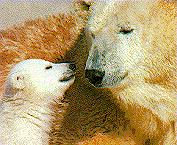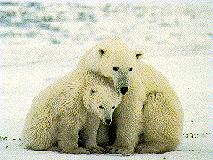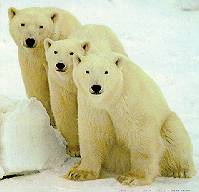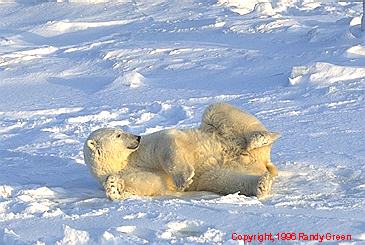Intr0
|
aBout M3
|
Fr3n Links
|
Fav0rSit3
|
PRohibit3D
|
Wit3BeaR
|
MetalSc3ne
|
Achive
|
SigN GB
|
View GB
A. Order - Carnivora.
The scientific order Carnivora includes bears, dogs, cats, raccoons,
otters, weasels, and their relatives. All typical carnivores have well
developed claws and a pair of specialized cheek teeth for cutting hard
foods.
B. Family - Ursidae.
All bears belong to this family. The family is divided into three
subfamilies, Ursinae (black bears, brown bears, polar bears, sloth
bears, and sun bears), Tremarctinae (spectacled bears), and Ailuropodinae
(giant pandas).
C. Genus, species - Ursus maritimus.
1. There are five other species in the genus Ursus: brown
bears, American black bears, Asiatic black bears, sun bears, and sloth
bears. Species can be distinguished by size, build, coloration, and habitat.
2. Ursus maritimus is Latin for "sea bear".
D. Fossil record.
The oldest known polar bear fossil is less than 100,000 years old.
Polar bears probably developed during the Pleistocene era from an ancestral
brown bear. Polar bears and brown bears are still closely related; when
cross-bred, they produce fertile offspring.
How They Communicate with Others
 A. Vocalizations.
A. Vocalizations.
1. Adult polar bears vocalize most when they're agitated or threatened.
Sounds include hissing, growling, champing of teeth, and soft chuffing.
2. Cubs vocalize more often and for diverse reasons. Sounds include
hissing, squalling, whimpering, lip smacking, and throaty rumblings.
3. Mothers warn cubs with a chuffing or braying sound.
B. Other communication.
1. Polar bears also communicate through sight, touch, and smell.
2. A male polar bear initiates play fighting by approaching another
male with its head down, mouth closed, and eyes averted. The bears usually
make contact by gently touching or "mouthing" each other around the face
and neck. They then proceed to rear up on their hind legs and try to push
each other over with their forepaws.
3. A mother polar bear can comfort, protect, or punish her cubs
by using her body, muzzle, or paws.
B. Habitat.

1. Polar bears inhabit Arctic sea ice, water, islands, and continental
coastlines.
2. Polar bears prefer sea ice habitat with leads, next to continental
coastlines or islands(Stirling, 1993).
a. Leads are water channels or cracks through ice which may remain
open (ice free) for only a few minutes to several months, depending upon
weather conditions and water currents.
b Polar bears hunt seals in the leads, using sea ice as a platform.
c. The "Arctic ring of life" is a biologically rich system of leads
and
polynyas. It runs parallel to the polar basin coastline.
(1)Polynyas are areas of water, surrounded by ice, that remain
open throughout the year due to winds, upwellings, and tidal currents.
(2)Polynyas are important breathing and feeding areas for wintering
or migrating marine mammals and birds.
3. Some polar bears spend part of the year on land.
a. Polar bears in warmer climates may become stranded on land.
In summer, sea ice melts along the coastlines, and pack ice (floating sea
ice, or floes, not connected to land) moves north.
b. Most pregnant females spend the autumn and winter on land in
maternity dens.
4. Air temperatures in the Arctic average -34C (-29F) in winter
and 0C (32F) in summer. The coldest area in winter is northeastern Siberia,
where the temperature has been recorded as low as -69C (-92F). The warmest
areas in summer are inland regions of Siberia, Alaska, and Canada where
temperatures can reach as high as 32C (90F).
5. The ocean temperatures in the Arctic are about -1.5C (29F) in
summer. In winter the ocean temperatures can drop to -2C (28F), at which
point seawater freezes.
The ocean and its inhabitants fascinate me, and this fascination
leads to a quest for knowledge and deeper understanding. Although it is
myintent to provide you with the most accurate information available, it
is possible that some of this information may change as research continues
and new discoveries are made. The nature of science is ever-changing.

1997 Ph@thul ( ) All Right Reserved



This Malaysian Hebat
WebRing site belongs to
DarK PhAtHuL.
Click for the
Previous
5 Sites
Skip
Previous
Previous
Next
Skip
Next
Next 5
Sites
Random
Site
List
Sites]
Click here to join
Malaysian HEBAT WebRing.
MeNu







